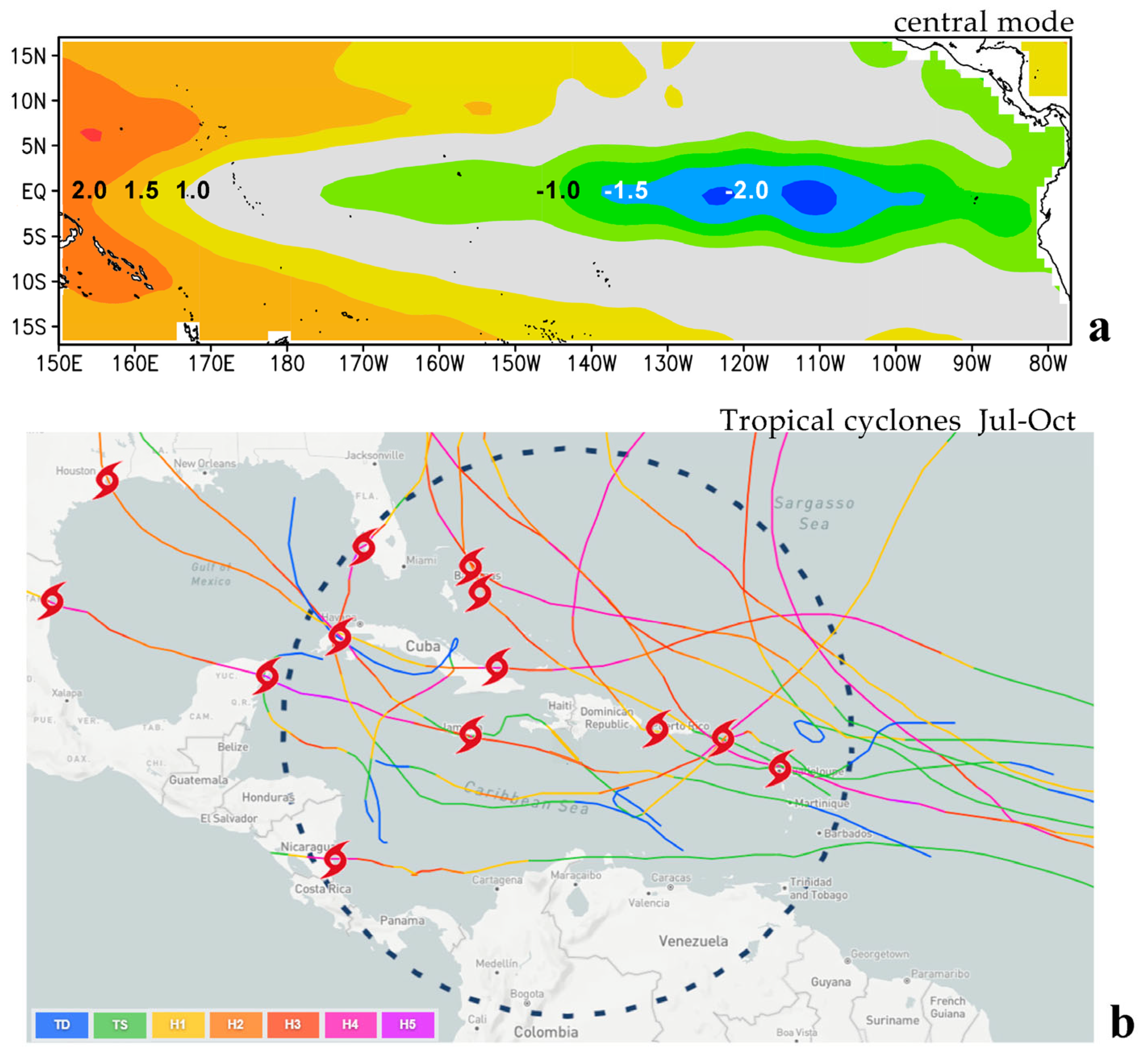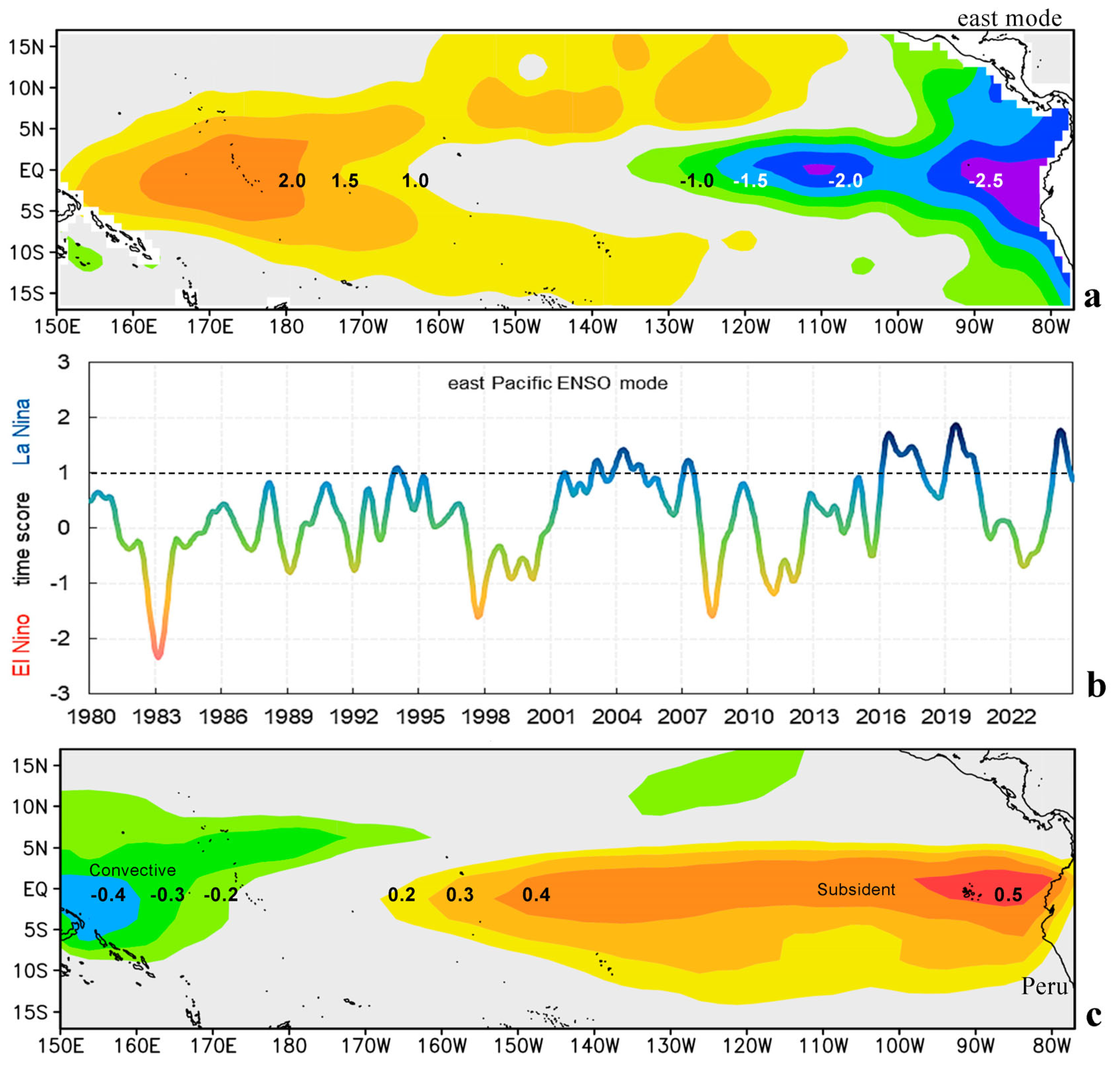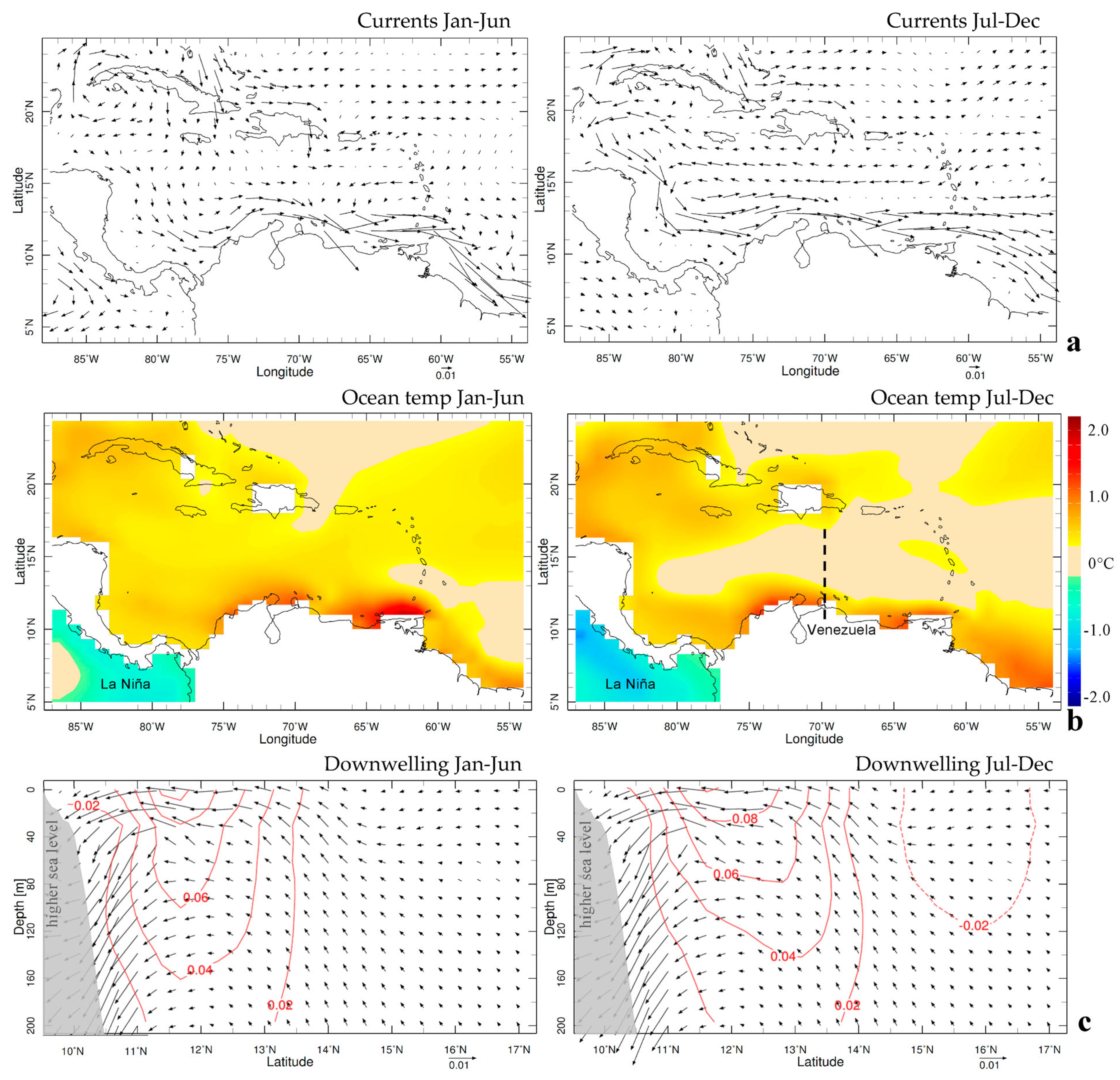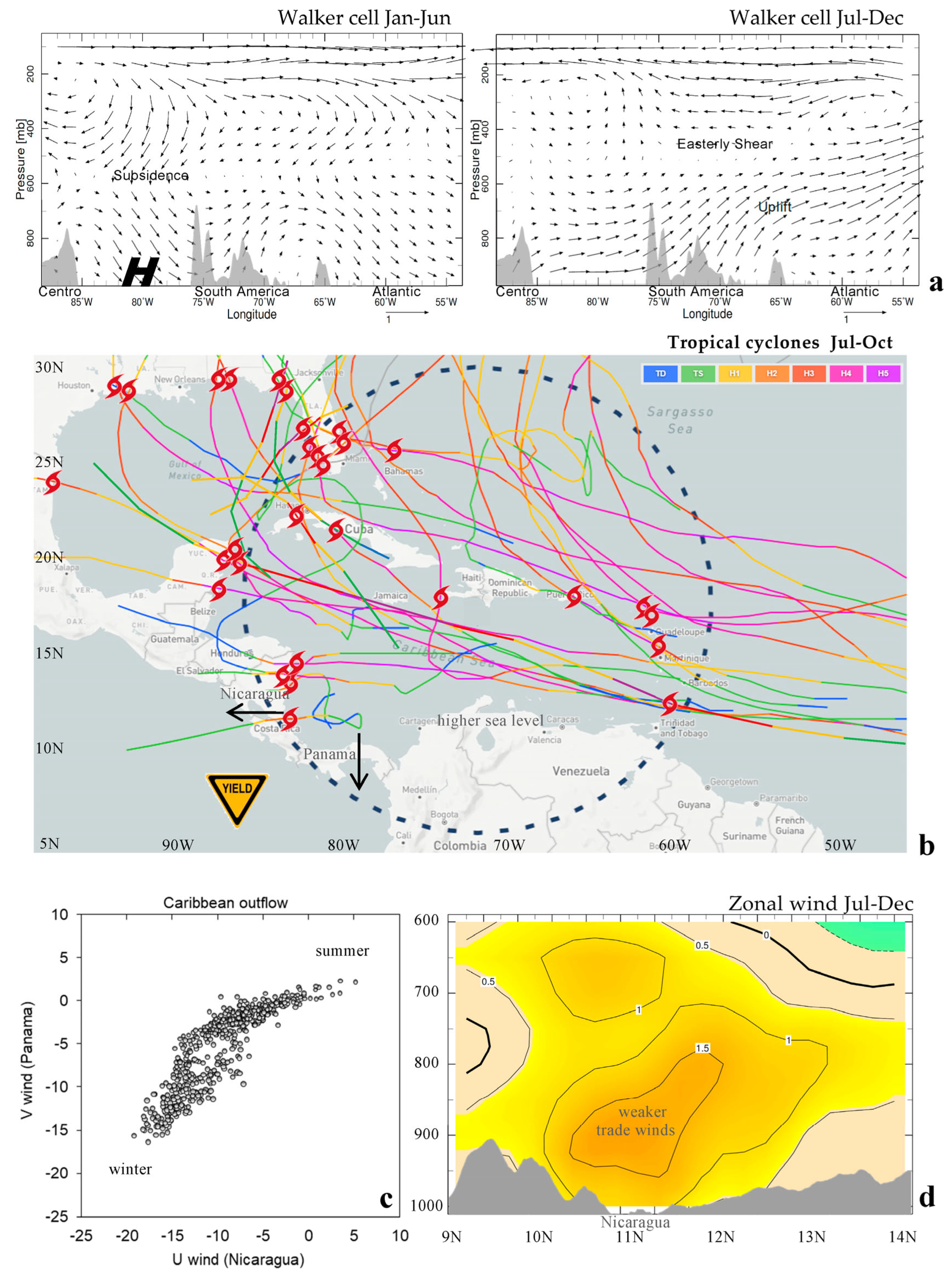Impact of East Pacific La Niña on Caribbean Climate
Abstract
1. Introduction
2. Data Analysis
3. Results
3.1. East Pacific Dipole Pattern and Time Score
3.2. Composite Atmospheric Maps
3.3. Composite Upper Ocean Conditions
3.4. Caribbean Wind Shear and Tropical Cyclogenesis
4. Concluding Discussion
Funding
Institutional Review Board Statement
Informed Consent Statement
Data Availability Statement
Acknowledgments
Conflicts of Interest
Appendix A

References
- Yang, X.; DelSole, T. Systematic comparison of ENSO teleconnection patterns between models and observations. J. Clim. 2012, 25, 425–446. [Google Scholar] [CrossRef]
- Jin, F.-F. An equatorial ocean recharge paradigm for ENSO, part I: Conceptual model. J. Atmos. Sci. 1997, 54, 811–829. [Google Scholar] [CrossRef]
- Picault, J.; Masia, F.; du Penhoat, Y. An advective-reflective conceptual model for the oscillatory nature of the ENSO. Science 1997, 277, 663–666. [Google Scholar] [CrossRef]
- Wang, C. A unified oscillator model for the El Niño–Southern Oscillation. J. Clim. 2001, 14, 98–115. [Google Scholar] [CrossRef]
- White, W.B.; Tourre, Y.M.; Barlow, M.; Dettinger, M. A delayed action oscillator shared by biennial, inter-annual, and decadal signals in the Pacific basin. J. Geophys. Res. 2003, 108, 3070. [Google Scholar] [CrossRef]
- MacMynowski, D.G.; Tziperman, E. Factors affecting ENSO’s period. J. Atmos. Sci. 2008, 65, 1570–1586. [Google Scholar] [CrossRef]
- Lin, J. Ocean-atmosphere interaction in the lifecycle of ENSO: The coupled wave oscillator. Chin. Ann. Math. Ser. B 2009, 30, 715–728. [Google Scholar] [CrossRef]
- Yang, G.Y.; Hoskins, B. ENSO impact on Kelvin waves and associated tropical convection. J. Atmos. Sci. 2013, 70, 3513–3532. [Google Scholar] [CrossRef]
- Gill, A.E. Some simple solutions for heat-induced tropical circulation. Q. J. R. Meteorol. Soc. 1980, 106, 447–462. [Google Scholar]
- Wang, C. Atmospheric circulation cells associated with the El Niño–Southern Oscillation. J. Clim. 2002, 15, 399–419. [Google Scholar] [CrossRef]
- Lee, S.-K.; Wang, C.; Mapes, B.E. A simple atmospheric model of the local and teleconnection responses to tropical heating anomalies. J. Clim. 2009, 22, 272–284. [Google Scholar] [CrossRef]
- Jury, M.R. Global wave-2 structure of ENSO-modulated convection. Int. J. Clim. 2019, 39, 2438–2448. [Google Scholar] [CrossRef]
- Yu, J.-Y.; Kao, H.-K. Decadal changes of ENSO persistence barrier in SST and ocean heat content indices: 1958–2001. J. Geophys. Res. 2007, 112, D13106. [Google Scholar] [CrossRef]
- Kao, H.; Yu, J. Contrasting eastern-Pacific and central-Pacific types of ENSO. J. Clim. 2009, 22, 615–632. [Google Scholar] [CrossRef]
- Xu, K.; Zhu, C.; He, J. Two types of El Niño-related Southern Oscillation and their different impacts on global land precipitation. Adv. Atmos. Sci. 2013, 30, 1743–1757. [Google Scholar] [CrossRef]
- Garreaud, R.D. A plausible atmospheric trigger for the 2017 coastal El Niño. Int. J. Clim. 2018, 38, e1296–e1302. [Google Scholar] [CrossRef]
- Hu, Z.Z.; Huang, B.; Zhu, J.S.; Kumar, A.; McPhaden, M.J. On the variety of coastal El Niño events. Clim. Dyn. 2019, 52, 7537–7552. [Google Scholar] [CrossRef]
- Peng, Q.H.; Xie, S.-P.; Wang, D.X.; Zheng, X.T.; Zhang, H. Coupled ocean-atmosphere dynamics of the 2017 extreme coastal El Niño. Nat. Comm. 2019, 10, 298. [Google Scholar] [CrossRef]
- Wang, C.; Deser, C.; Yu, J.-Y.; DiNezio, P.; Clement, A. El Niño-Southern Oscillation (ENSO): A review. In Coral Reefs of the Eastern Pacific; Glymn, P.W., Manzello, D.P., Enochs, I.C., Eds.; Springer: Berlin/Heidelberg, Germany, 2016; pp. 85–106. [Google Scholar]
- Patricola, C.M.; Chang, P.; Saravanan, R. Degree of simulated suppression of Atlantic tropical cyclones modulated by flavour of El Niño. Nat. Geosci. 2016, 9, 155–160. [Google Scholar] [CrossRef]
- Mueller, T.J.; Patricola, C.M.; Bercos-Hickey, E. The influence of ENSO diversity on future Atlantic tropical cyclone activity. J. Clim. 2024, 37, 3959–3975. [Google Scholar] [CrossRef]
- Levitus, S.; Antonov, J.L.; Boyer, T.P.; Baranova, O.K.; Garcia, H.E.; Locarnini, R.A.; Mishonov, A.V.; Reagan, J.R.; Seidov, D.; Yarosh, E.S.; et al. World Ocean heat content and thermosteric sea level change (0–2000 m) 1955–2010. Geophys. Res. Lett. 2012, 39, L10603. [Google Scholar] [CrossRef]
- Lee, H.-T. Climate Algorithm Theoretical Basis Document: Outgoing Longwave Radiation (OLR). NOAA’s Climate Data Record (CDR) Program, CDRP-ATBD-0526. 2014; p. 46. Available online: https://www.ncei.noaa.gov/pub/data/sds/cdr/CDRs/Outgoing%20Longwave%20Radiation%20-%20Daily/AlgorithmDescription_01B-21.pdf (accessed on 17 April 2025).
- Gelaro, R.; McCarty, W.; Suárez, M.J.; Todling, R.; Molod, A.; Takacs, L.; Randles, C.A.; Darmenov, A.; Bosilovich, M.G.; Reichle, R.; et al. The modern-era retrospective analysis for research and applications v2 (Merra2). J. Clim. 2017, 30, 5419–5454. [Google Scholar] [CrossRef]
- Penny, S.G.; Behringer, D.W.; Carton, J.A.; Kalnay, E. The hybrid global ocean data assimilation system at NCEP. Mon. Weather. Rev. 2015, 143, 4660–4677. [Google Scholar] [CrossRef]
- Kim, K.Y. Investigation of ENSO variability using cyclostationary EOFs of observational data. Meteorol. Atmos. Phys. 2002, 81, 149–168. [Google Scholar] [CrossRef]
- National Hurricane Center. 1980–2024: Annual Reports on Atlantic Hurricanes; NOAA: Miami, FL, USA, 2024. [Google Scholar]
- White, W.B. Tropical coupled Rossby waves in the Pacific ocean–atmosphere system. J. Phys. Oceanogr. 2000, 30, 1245–1264. [Google Scholar] [CrossRef]
- Peng, Q.; Xie, S.-P.; Passalacqua, G.A.; Miyamoto, A.; Deser, C. The 2023 extreme coastal El Niño: Atmospheric and air-sea coupling mechanisms. Sci. Adv. 2024, 10, eadk8646. [Google Scholar] [CrossRef] [PubMed]
- Chang, Y.-L.; Oey, L.-Y. Coupled response of the trade wind, SST gradient, and SST in the Caribbean Sea, and the potential impact on Loop Current inter-annual variability. J. Phys. Oceanogr. 2013, 43, 1325–1344. [Google Scholar] [CrossRef]
- Cherubin, L.M.; Richardson, P.L. Caribbean current variability and the influence of the Amazon and Orinoco freshwater plumes. Deep. Sea Res. 2007, 54, 1451–1473. [Google Scholar] [CrossRef]
- Torres, R.R.; Latandret, S.; Salon, J.; Dagua, C. Water masses in the Caribbean Sea and sub-annual variability in the Guajira upwelling region. Ocean. Dyn. 2023, 73, 39–57. [Google Scholar] [CrossRef]
- Tartaglione, C.A.; Smith, S.R.; O’Brien, J.J. ENSO impact on hurricane landfall probabilities for the Caribbean. J. Clim. 2003, 16, 2925–2931. [Google Scholar] [CrossRef]




Disclaimer/Publisher’s Note: The statements, opinions and data contained in all publications are solely those of the individual author(s) and contributor(s) and not of MDPI and/or the editor(s). MDPI and/or the editor(s) disclaim responsibility for any injury to people or property resulting from any ideas, methods, instructions or products referred to in the content. |
© 2025 by the author. Licensee MDPI, Basel, Switzerland. This article is an open access article distributed under the terms and conditions of the Creative Commons Attribution (CC BY) license (https://creativecommons.org/licenses/by/4.0/).
Share and Cite
Jury, M.R. Impact of East Pacific La Niña on Caribbean Climate. Atmosphere 2025, 16, 485. https://doi.org/10.3390/atmos16040485
Jury MR. Impact of East Pacific La Niña on Caribbean Climate. Atmosphere. 2025; 16(4):485. https://doi.org/10.3390/atmos16040485
Chicago/Turabian StyleJury, Mark R. 2025. "Impact of East Pacific La Niña on Caribbean Climate" Atmosphere 16, no. 4: 485. https://doi.org/10.3390/atmos16040485
APA StyleJury, M. R. (2025). Impact of East Pacific La Niña on Caribbean Climate. Atmosphere, 16(4), 485. https://doi.org/10.3390/atmos16040485








